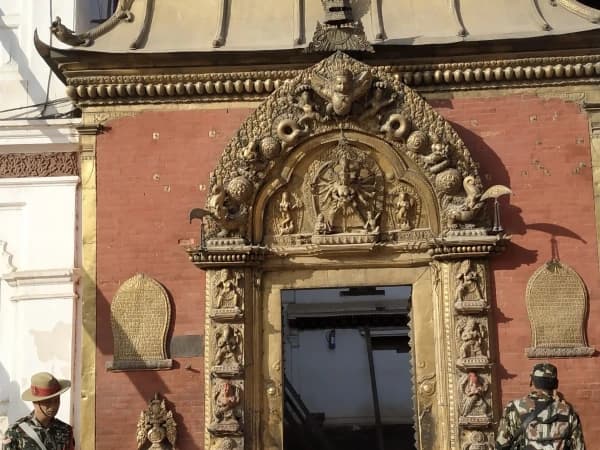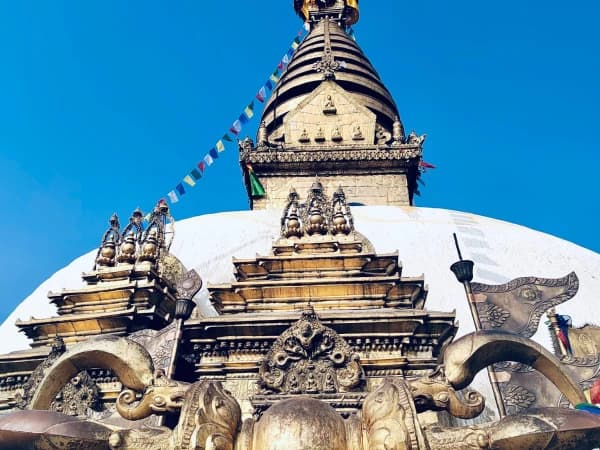Overview of Kathmandu Day Tour
Kathmandu Day Tour is a perfect day excursion to enjoy the beauty of Nepal's finest cultural and Historical landmarks, reflecting the architectural prowess of the ancient Kingdom of Nepal. The Valley of Kathmandu boasts seven UNESCO Cultural World Heritage Sites in total, and on the sightseeing tour organized by View Nepal Treks and Expedition, you will be visiting all seven of them. You will be accompanied by a Multilingual Cultural Guide for your sightseeing tour, who will share the information surrounding the landmarks and historical sites.
The Kathmandu Day tour begins at around 8 AM as the sightseeing vehicle picks you up from your hotel and transports you to Soyambhunath Stupa situated on top of the Gosringa (Semgu) Hill, you can witness stellar views of the Kathmandu Valley and if the weather is clear then the views of the Langtang, Rolwaling Himalayan Range can be seen behind the lush green hills on the outskirts. After exploring the holy stupa, you will be transferred to Basantapur/ Kathmandu Durbar Square complex, which is one of the busiest hubs of the capital, as one of the major markets in Kathmandu is situated at the northern part of the Durbar Square. You can also purchase souvenirs from the local vendors, as there is a wide range to select from at affordable prices. Next destination will be to Boudhanath Stupa, exploring the tranquil Stupa’s vicinity, even though located within one of the busiest parts of the Capital. You will be transferred from Boudhanath Stupa to Pashupatinath Temple, one of the major pilgrimage sites for Hindu followers, dedicated to Lord Shiva. After the completion of the Kathmandu Day Tour, you will be dropped back at your hotel, marking the end of the day tour.
After the completion of the day 1 Kathmandu Day Tour, the next day you will explore Patan Durbar Square and Bhaktapur Durbar Square, which are also known to be a living museum and rich in art, architecture, and historical monuments from the 2nd century. After that, you will be driven to Nagarkot hills for relaxation and a mountain view. If the weather is favourable, you can see Everest and the Himalayan range.
Highlights of the Kathmandu Day Tour
- Exploring the UNESCO World Heritage Sites within the Kathmandu Valley
- Plenty of time to explore each of the iconic landmarks, accompanied by a Cultural Guide.
- Have an inside view of the Nepalese lifestyle.
- Have a better understanding of the landmarks, including their history, myths, architectural styles, and many more.
- Exquisite view of the Kathmandu Valley from the Swayambhunath Hill.
- Sunrise view from Nagarkot hills and Alluring mountain views, including the world's highest mountain, Mount Everest.
- Opportunity to try cultural meals from the Nepalese Cuisine.
- Purchase local souvenirs from the market vendors.
About Sightseeing Destinations
Swayambhunath Stupa
Swayambhunath Stupa, also called the Monkey Temple, is one of the most revered and sacred sites of the country, located on top of the Gosringa Hill. The Swayambhunath Temple's origin can be traced as far as the 5th century AD. However, according to various folklores, the origin of the Swayambhunath dates back even further, as it is believed that the Stupa was formed when a lotus flower bloomed in the middle of the Lake which covered the entire valley of Kathmandu. The Bodhisattva Manjuri is said to be responsible for draining the water from the valley, which he did by cutting down the Chobar hill using his flame sword, Khadga. The site has been serving as one of the pivotal points for Buddhist pilgrimage for centuries, and also for the Hindu community. The name Swayambhunath means “self-manifested” or “self-born”. The stupa is constructed on a dome-shaped structure, abode with a golden spire on top of it. The wisdom eyes of the Buddha are facing the four cardinal directions, symbolizing his omnipresent awareness. The stupa is surrounded by various shrines, temples, and statues which are dedicated to some Hindu deities, including lord Shiva, the God of destruction. The Swayambhunath Stupa is also a beautiful viewpoint overlooking the Kathmandu Valley and the Himalayas in the background. The iconic landmark has been serving as a center of spiritual practice and Nepalese heritage, attracting both pilgrims and tourists. The Stupa has gone through various renovation projects, among which took place during “the golden age of art and culture”, the Malla period. The stupa can be accessed by visitors after climbing a flight of 365 stairs.

Banasantapur Durbar Square
Basantapur Durbar Square has been the center of the major political events of the country for centuries. The Durbar Square had been serving as the Royal residence till the late 19th century, after which the royals shifted to the Narayanhiti Royal Palace. The iconic landmark's origin dates back to the Licchavi period, who ruled from the 4th century to the 9th century AD, but was developed massively under the Malla Kings. The site has served for major political events, including royal coronations, festivals, celebrations, as well as massacres, which shifted the nation’s trajectory massively. The complex holds various monuments built during the ruling of different dynasties, each showcasing unique architectural characteristics. The iconic temples of the site include Hanuman Dhoka Royal Palace, Kumari Ghar (home of the living Goddess), Taleju Temple, and many more. The architectural wonderland was listed as a UNESCO World Heritage Site in 1979 AD and has been one of the must-visit places for local and international tourists. The restoration process of the damaged monuments is at its final stages, as the landmarks were severely damaged during the earthquake of 2015 AD.

Pashupatinath Temple
The Pashupatinath Temple is constructed on the banks of the holy Bagmati River in Kathmandu, is one of the most significant and revered sites for the Hindu community all around the world. The temple is dedicated to the lord of Destruction, Lord Shiva in his Pashupati form, meaning the “lord of beasts,” and according to the factual data, the temple dates back to around the 5th century AD but has undergone multiple expansions and renovation processes. The major renovation process took place during the ruling of King Ananta Malla, who also added a roof to the temple. The temple attracts devotees all around the world daily, but during the annual festival of Janai Purnima and Maha Shiva Ratri, the temple is crowded as thousands of devotees stay in line waiting for their turn from as early as 2 AM. The sprawling temple complex also includes various shrines and statues. The bank of the Bagmati River also serves as one of the biggest cremation sites of the Hindu community in Nepal, as, according to the faith of believers, the devotees who are cremated there find their path to the next life easily. The temple was listed as a UNESCO World Heritage site in 1979 AD. The temple also symbolizes Nepal’s deep-rooted connection with Hinduism.
Note: The followers of Hinduism are only permitted to enter the main vicinity of the Pashupatinath Temple, and non-Hindus are not permitted within the vicinity but can explore other parts of the grand temple complex freely.
Boudhanath Stupa
Boudhanath Stupa is one of the most revered religious sites for Buddhism all around the world, located in the North-East part of the Kathmandu valley. The Stupa is believed to have been constructed during the 5th century AD and brought to its current form/ structure during the 14th century during the Malla Period. The Stupa, according to Buddhist folklore, is constructed over the remains of a Buddhist Monk, which later became a symbol for peace and enlightenment. The Stupa symbolizes the universe through its massive mandala design. The Stupa stands tall at around 36 M in a dome shape surrounded by 108 small stupas and statues, making it one of the biggest stupas of Nepal. At the top of the dome, the all-seeing eyes of Buddha, representing wisdom, and a third eye representing spiritual insight, are painted on the four faces of the Stupa. The pilgrimage visitors are often seen walking around the Stupa in a clockwise direction, chanting their mantras/ prayers and spinning the prayer wheels constructed around the dome of the Stupa. The Stupa has been a UNESCO World Heritage Site since 1979 AD.

Patan Durbar Square
Patan Durbar Square is an architectural marvel built in the Newari architectural style, which served as the Royal residence of the Malla Dynasty from the early 14th century to the 19th century AD. Patan Durbar Square portrays the architectural prowess of the ancient Kingdom and is listed among the UNESCO Cultural World Heritage Sites. Patan Durbar Square is considered the oldest durbar square among the three durbar squares: Kathmandu Durbar Square, Bhaktapur Durbar Square, and Patan Durbar Square. The ancient city of Patan was previously called “Yala” by its first inhabitants, the Newari. The city later on got the name Lalitpur, which translates to “a beautiful place”. The surrounding of the Patan Durbar Square also boasts a number of intricate temple complexes, including the Golden Temple (the oldest temple of Patan, believed to have been constructed during the 12th century AD), Baglamukhi Temple, and many more. The Patan Museum is also located within the vicinity of Patan Durbar Square, filled with intricate monuments including wood carvings, bronze idols, stone carvings, and many more.

Bhaktapur Durbar Square
Bhaktapur Durbar Square is an old royal plaza in Bhaktapur city, Nepal. Built between the 12ᵗʰ–18ᵗʰ centuries by the Malla kings, it was their palace and main gathering place during the jatras and festivals. Its main highlights are amazing Newari art, beautiful carved wood, stone, and brick buildings. The 55‑Window Palace and Golden Gate lead to the Taleju Temple. The five‑story Nyatapola Temple, dedicated to the goddess Siddhi Laxmi, is one of the tallest pagodas in Nepal. You can also see Vatsala Temple, Bhairavnath, and many shrines. Though damaged in the 1934 and 2015 earthquakes, it has been restored and is now a UNESCO World Heritage Site. Today, the square is alive with festivals, pottery-makers, woodcarvers, and prayers, a place where history meets daily life.
Changunarayan Temple
Changunarayan Temple, located on a hill about 12 km east of Kathmandu in Bhaktapur, is Nepal’s oldest Hindu temple, built during the Licchavi period (4ᵗʰ–5ᵗʰ century) and dedicated to Lord Vishnu.. The two‑tiered pagoda-style temple features a gilded copper roof, intricate wood, metal, and stone carvings of deities, mythical creatures, and Vishnu’s avatara, as you walk in, you'll see life‑sized lions, elephants, and griffins guarding four entrances, and artistic reliefs like Garuda and a legendary stone inscription from 464 AD the oldest in Nepal left by King Mānadeva. This UNESCO World Heritage site invites you into a peaceful, spiritual world. Festivals like Haribodhini Ekadashi bring color and devotion, making your visit a blend of ancient history and living tradition.
Nagarkot Hill
Nagarkot Hill is the perfect final destination to relax and unwind at the end of your Kathmandu Valley tour. Located just 32 km from Kathmandu at an altitude of 2,195 meters, it offers peace, fresh mountain air, and breathtaking views of the Himalayas. It’s famous for both sunrise and sunset—on clear days, you can even catch a glimpse of Mount Everest glowing in golden light. Surrounded by pine forests and quiet villages, Nagarkot is an ideal place to escape the city noise and recharge. You can enjoy scenic hikes, sip tea on a peaceful terrace, or simply sit back and watch the changing colors of the sky. After days of exploring temples and cities, this hilltop offers the perfect place to rest, reflect, and enjoy nature’s beauty. Whether you’re with friends, a partner, or traveling solo, Nagarkot will give your journey a peaceful and memorable ending.

.webp&w=3840&q=75&dpl=dpl_CxxfRaG2N8WHMLZc2DJBWsSsXcmw)
.webp&w=3840&q=75&dpl=dpl_CxxfRaG2N8WHMLZc2DJBWsSsXcmw)
-1.webp&w=1200&q=75&dpl=dpl_CxxfRaG2N8WHMLZc2DJBWsSsXcmw)
.webp&w=1200&q=75&dpl=dpl_CxxfRaG2N8WHMLZc2DJBWsSsXcmw)

.webp&w=1200&q=75&dpl=dpl_CxxfRaG2N8WHMLZc2DJBWsSsXcmw)

